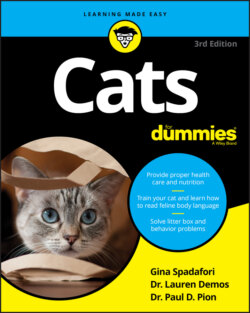Читать книгу Cats For Dummies - Gina Spadafori - Страница 26
Should You Consider a Pedigreed Cat?
ОглавлениеYou should consider everything! Although pedigreed cats make up a very small percentage of the overall cat population — less than 5 percent, according to some sources — some people would never consider having anything but a pedigreed cat of their particular favorite breed.
One fan of pedigreed cats is the late Lilian Jackson Braun, whose best-selling The Cat Who … mysteries charmed cat lovers for years. Braun’s breed of choice was the Siamese, and so, too, is her detective’s. In fact, if not for that very first Siamese cat, a gift from her husband, there would probably be no such mystery series at all.
Although the development of dog breeds has been going on for as long as dogs have been around, the interest in purebred cats is a relatively recent phenomenon, starting in the 19th century. Probably the most compelling reason for the difference is that people needed dog breeds to perform various tasks — herding, hunting, and guarding — whereas the cat walked in perfectly suited to the needs of humankind: Then, as now, no more efficient hunter of rodents could be found. Why mess with perfection?
Some people have always appreciated cats as much for their beauty and companionship as for their hunting skills, and some of these folks have worked to preserve and develop cat breeds and to nurture the development of new — and ofttimes controversial — varieties.
What are the benefits of owning a pedigreed cat? Predictability is probably the main one: If you buy a pedigreed kitten from a reputable breeder, you know in large part what you’re getting. Size, body type, coat color, and levels of activity and vocality are imprinted on each kitten at the time of conception. Although each cat is still an individual, you can rest assured that your individual Siamese is going to have more in common with other Siamese in terms of looks and personalities than it does with any Persian ever born. The Siamese is active and talkative; the Persian is calm and quiet. If your tastes in a feline companion run to either of these extremes, choosing an appropriate pedigreed cat is the most likely way to have your wish.
Pedigreed cats also offer a little more variety than the everyday cat does. If you like a long, sleek cat, certain breeds fit that profile. The same, too, is true for a thicker-set body type, called cobby by fanciers. Color choices, too, are broader. The slate gray of the Korat and Russian Blue, really a dilution of the gene that produces black, is almost unheard-of outside the world of pedigreed cats, as is the glossy warm tone of the Havana Brown.
And what about the novelty factor? Only in the pedigreed ranks can you find cats with ears that fold forward or back, cats with kinky fur — or none at all — and cats with little or no tails or short legs. Some of these breeds are controversial — to say the least! — but they certainly do expand the choices when the time comes to “think cat.”
Concerning pedigreed cats, cat lovers like them big, and they like them furry. Or at least that’s the picture you get from the Cat Fanciers’ Association, which lists heavy breeds in the top few slots: Exotic (a short-haired version of the Persian), Ragdoll, British Shorthair, and Maine Coon. Worldwide, there are close to 50 cat breeds, many so rare that only a few hundred representatives exist in each.
The overwhelming majority of cat seekers do not choose a pedigreed cat. For some, the choice may be a matter of price and convenience. Pedigreed cats can be expensive — a couple of hundred dollars, at least, and climbing into the thousands of dollars for kittens of rare breeds and colors. They can be hard to find, too, if you journey past the most-popular breeds. Upkeep on the coats of some breeds may also limit many cat lovers to admiring them from afar. In addition to the difficulties keeping long, silky coats in order, some breeds have become increasingly short-faced (the veterinary term is brachycephalic), which in cats as in dogs can be a source of significant health issues.
Although most pedigreed cats are as healthy as their nonpedigreed relatives, you do need to be aware of some health concerns. Some varieties of the Persian, for example, are prone to respiratory problems, blocked tear ducts, and runny eyes because of the short face that some breeders prize. In response, other breeders are specializing in Persians without the deformities, although even those Persians share with their short-nosed relatives a high incidence of kidney disease. It’s not just Persians, though. Skeletal defects can pop up in Scottish Fold and Manx litters, for example, and Maine Coons and Siberians are prone to certain heart conditions.
